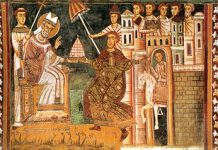Saint Catherine de Ricci (1522 – 1590) – born Alessandra Lucrezia Romola de’ Ricci – was from the same city, Florence, as her contemporary Saint Philip Neri, to whom she appeared by bilocation, one of the very few miracles in his own life to which Philip attested. As he put it, secretum meum mihi – my secret is my own, and what we know of the saints is the least part of them.
Catherine – who, after being raised in a Benedictine convent, at the age of 13 took the name upon entering the Third Order Dominican Sisters like her patron of Siena two centuries earlier – lived a life ‘hidden with God’. At first, she seemed clumsy and distracted, so given was she to contemplation, that the Sister thought of dismissing her. But her gifts were soon recognized, and Sister Catherine appoint prioress. Her administrative abilities were exemplary, and she seemed to do all things well, corresponding with future Popes and prelates, offering sage advice with what seemed at least partly supernatural and infused knowledge and prudence. All the while, she received visions of Our Lady and Christ, as a child, and in His suffering. And suffer she did, in sympathy with Christ’s Passion, she bore the stigmata, and her asceticism more to be admired than imitated, even if her regime of fasting and her taming of her body should give us some food for thought as we enter into our own, likely less rigorous, Lenten regimes.
The main point is that Saint Catherine de Ricci did all this out of love, as should we. She died after a long illness in 1590, and was canonized by Pope Benedict XIV in 1746. Her incorrupt body is on display in the basilica named after her in Prato, Italy.











